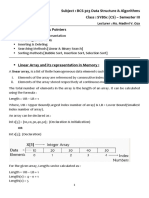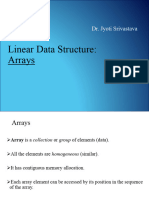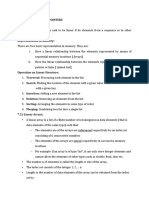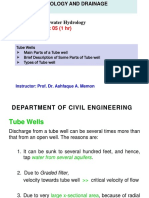array
Uploaded by
jecrcdon123array
Uploaded by
jecrcdon123(8)
Reference Notes
Some points to be revised again
4) An array is a collection of similar elements
(2) The first element in the array is numbered0, so the
last element is 1 less than the size of
the array.
(3) Before using an array its type and dimension must be declared.
4) Array element are always stored in continuous memory locations.
Size of the array remains constant.
More Than One Dimension
So far we have explored arrays with only one
dimension. t is alsopossible for arrays to
have two or more dimensions. The two dimensional arrays is also
calleda matsix.
Initializing A 2-Dimensional Array
We can initialize a two dimensional array ljke. ......
int stud[4J[2]
1234,56
#1212,33},
1342, 32},
{2145, 46}
Or we can also initialize like this......
int stud[4]2] = (1234,56, 1212, 33, 342, 32, 2145,46):
It is important to remember that while initializing an array it is necessary to mention the
Second (column) dimension, whereas the first dimension (row) is optional.
Thus the declarations,
int arr[2][3] = (1, 2, 3, ,4, 5, 6};
int arr[ ][3] = {1, 2, 3, 4, 5, 6};. are perfectly acceptable.
(10) Reference Notes
Traversing Linear Arrays
Let Abe a collection of data elements stored in the
memory of the computer. Suppose we
want to print the contentsS of each element of A or suppose we want to count the
number of
elements of A with a given property. 1his can be acComplished by traversing A, i.e., by
accessing and processing each element of A e'xactly one.
Algorithm (Traversing a Linear Array) TRAVESE (A, LB, UB)
Here A is a linear array with lower bound LB and upper bound UB. This
algorithm
traverses A applying an operation process to each element of A
STEP I: [Initialize counter] Set K:-LB.
STEP 2: Repeat Steps 3 and 4 while K<sUB.
STEP 3: [visit element] Apply process to A(K)
STEP 4 : [Increase counter] Set KK+
[End of Step 2loop]
STEP 5: " Exit.
Inserting and Deleting Element
Let Abe a collection of data elements i the memory of the computer. "Inserting" refers
to the operation of adding another element to the collection A, and deleting" refers to the
operation of removing one of the elements fronA.
Algorithm Inserting into a Linear Array) INSERT (A,N, K, ITEM)
Here a is alinearaey with Nelements and Kis apositive integer such that K<=N. This
algorithm inserts an element TEM into the Kth position in A.
STEP 1: Injtialize counter] Set J:=N.
STEP 2: Repeat Steps 3 and 4 while J>=K.
STEP 3: [Move Jth element downwards] Set A[J+1]:=AJ].
STEP 4: (Decrease counter] Set J := J-1.
[End of Step 2:loop]
STEP 5: [Insert element.] Set A[K]: ITEM.
STEP 6: (Reset N.] Set N:=N+1.
STEP 7: Exit.
Arrays (|1)
Algorithm (Deleting from a LinearArrav) DELETE (A, N, K, ITEM)
Here A is a linear array with N elements and K is a positive integer such that K<=N. This
algorithm deletes the Kth element from A.
STEP I: Set ITEM := A[KJ.
STEP 2 :
Repcat steps 3and 4 while J = K to N-1.
STEP 3: [Move Jth element upwards] Set A(J]:FAJ+1].
STEP 4: [Increase counter Set J := J+1.
[End of Step 2 loop]
STEP S: |Reset the number Nof elements in A]Set N N-1.
STEP 6: Exit.
Searching element from a Linear Array
Searching is the process of finding the locatiÑn of given element in the linear array. The
search is said to be successful if the given element is foundfe. the element
does eXISt n ne
array, otherwise search is said to be unsuccessful.
There are two ways to search any element :
(a) Linear Search (b) Binary.Search
Linear Search
The method which tràyerses array sequendally to locate item is called Linear search or
sequential search. In the best posSible case, the item may occur at frst position. In this case, the
search operation terminates in success withjuat one comparison. However the worst case occurs
when either the item is present at last position or missing from the array. Thus in worst case the
linear searçh is O(n) operaiions
Algorithm (Linear Scarch) LINEAR_SEARCH (A, N, ITEM, LOC)
Here A is the Linear array with Nelements and ITEM is a given item of the information.
This procedure finds the locations LOCof 1TEM in A or sets LOC=0 if the search is
unsuccessful.
STEP 1: [Initialize LOC] Set LOC: = 0.
STEP 2: [Initialize counter] Set I:=1
STEP 3: Repeat step 5 and 5 while |<=N
STEP 4 : IF AU]= ITEM, then [If item found]
Set LOC:=land Exit.
You might also like
- Linear Arrays Representation & Traversal Insertion Deletion Linear Search Bubble Sort Binary SearchNo ratings yetLinear Arrays Representation & Traversal Insertion Deletion Linear Search Bubble Sort Binary Search18 pages
- Linear Arrays Representation & Traversal Insertion Deletion Linear Search Bubble Sort Binary SearchNo ratings yetLinear Arrays Representation & Traversal Insertion Deletion Linear Search Bubble Sort Binary Search18 pages
- University Institute of Computing: Bachelor of Computer Application Subject Name: Data Structure Code:CAT-201No ratings yetUniversity Institute of Computing: Bachelor of Computer Application Subject Name: Data Structure Code:CAT-20117 pages
- Laecture 2:linear Data Structure:ArraysNo ratings yetLaecture 2:linear Data Structure:Arrays22 pages
- 11 - Data Structures and Algorithms - ArraysNo ratings yet11 - Data Structures and Algorithms - Arrays17 pages
- Data Structure and Algorithm: Lecture-10-11-12: ArrayNo ratings yetData Structure and Algorithm: Lecture-10-11-12: Array52 pages
- L5 - CD 303 Array and Its Operations With Memory RepresentationNo ratings yetL5 - CD 303 Array and Its Operations With Memory Representation3 pages
- 1D Array Introduction, Insertion, DeletionNo ratings yet1D Array Introduction, Insertion, Deletion11 pages
- Data Structure and Algorithm CS-102/CS2005No ratings yetData Structure and Algorithm CS-102/CS200543 pages
- Data Structure and Algorithm CS-102/CS2005No ratings yetData Structure and Algorithm CS-102/CS200543 pages
- Data Structure and Algorithm CS-102/CS2005No ratings yetData Structure and Algorithm CS-102/CS200543 pages
- A309386481_11115_19_2025_Operations on Linear ArrayNo ratings yetA309386481_11115_19_2025_Operations on Linear Array24 pages
- (PDF) Inhibition of Corrosion - Mechanisms and Classifications An OverviewNo ratings yet(PDF) Inhibition of Corrosion - Mechanisms and Classifications An Overview9 pages
- In Vitro Multiplication and Protocorm Development of Dendrobiumaphyllum (2011)No ratings yetIn Vitro Multiplication and Protocorm Development of Dendrobiumaphyllum (2011)7 pages
- An R Package For The Study of Beta DiversityNo ratings yetAn R Package For The Study of Beta Diversity5 pages
- Get Responsive Collaboration For IEP and 504 Teams 1st Edition Albert Johnson-Mussad Free All Chapters100% (15)Get Responsive Collaboration For IEP and 504 Teams 1st Edition Albert Johnson-Mussad Free All Chapters84 pages
- Department of Education: Granja Kalinawan National High SchoolNo ratings yetDepartment of Education: Granja Kalinawan National High School26 pages
- SINDA FLUINT General Purpose Thermal Fluid Network AnalyzerNo ratings yetSINDA FLUINT General Purpose Thermal Fluid Network Analyzer1,602 pages
- Engineering Maintenance Management (Industrial Engineering) (Benjamin W. Niebel)No ratings yetEngineering Maintenance Management (Industrial Engineering) (Benjamin W. Niebel)669 pages
- [Ebooks PDF] download (Ebook) Grieve's modern musculoskeletal physiotherapy by Jull, Gwendolen(Editor);Moore, Ann P(Editor);Falla, Deborah(Editor);Lewis, Jeremy(Editor) ISBN 9780702051524, 0702051527 full chapters100% (2)[Ebooks PDF] download (Ebook) Grieve's modern musculoskeletal physiotherapy by Jull, Gwendolen(Editor);Moore, Ann P(Editor);Falla, Deborah(Editor);Lewis, Jeremy(Editor) ISBN 9780702051524, 0702051527 full chapters67 pages
- 2021 Energy Institute - Safe Staffing LevelsNo ratings yet2021 Energy Institute - Safe Staffing Levels106 pages
- Phase 1: Interlocutor: Speaking Test Part 1 (3 - 4 Mins) : General QuestionsNo ratings yetPhase 1: Interlocutor: Speaking Test Part 1 (3 - 4 Mins) : General Questions8 pages

























































































